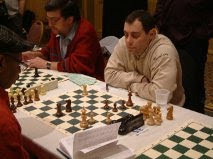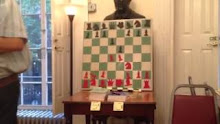 Candidate master Lev Zilbermintz [pictured] analyzes a recent victory, from the Garden State Chess League, in the Newark Gambit.
Candidate master Lev Zilbermintz [pictured] analyzes a recent victory, from the Garden State Chess League, in the Newark Gambit.West Orange vs. Sparta Match
Garden State Chess League
Round 4
West Orange, NJ
4 January 2011
White: Angelo DePalma (USCF 1980)
Black: Lev Zilbermintz (USCF 2134)
Philidor Counter Gambit
Newark Gambit Declined, 5.Bb3
1.e4 e5 2.Nf3 d6 3.d4 f5 4.Bc4 b5!?
This is the Newark Gambit, which I invented in 2003. It can get very tactical and complicated.
5.Bb3
After thinking for 10 minutes, my opponent decides to play it safe and retreat. Capturing the pawn with 5.Bxb5+ c6 gives Black plenty of compensation, as I have pointed out in my Atlantic Chess News articles on this opening. Three examples:
a) 5.Bxb5+ c6 6.Bc4 fxe4 7.Ng5 d5 8.Bb3 exd4 9.Nxe4 dxe4 10.Qh5+ Kd7 11.Qf7+ Qe7 12.Be6+ Kd8 13.Bg5 Nf6!, White resigns, doremon (ICC 2319) - Zilbermintz, 5 0 unrated blitz game, Internet Chess Club, 5 January 2011.
b) 5.Bxb5+ c6 6.Bc4 fxe4 7.Nxe5?! dxe5 8.Qh5+ Kd7 9.dxe5 g6 10.e6+ Ke8 11.Qe5 Qf6 12.Qc7 Ne7 13.Nc3 Qd4 14.Be3 Qxc4 15.O-O-O Qxe6 16.Rd6 Qf5 17.Rd8+ Kf7 18.Bd4 Rg8 19.Re1 Na6 20.Nxe4 Bh6+ 21.Kb1 Bf4! 22.Qxe7+ Kxe7 23.Rxg8 Kf7? (More accurate is 23...Kd7!) 24.Rg7 Kf8 25.Rxh7 Be5 26.Ng3 Bxg3 27.Rh8+ Kf7 28.Rh7+ Kg8 29.Rh8+ Kf7 30.Rh7+ Kf8 31.Rh8+ Kf7, 1/2-1/2 by three-time repetition, doremon (ICC 2319) - Zilbermintz, 5 0 unrated blitz game, Internet Chess Club, 5 January 2011.
c) 5.Bxb5+ c6 6.Bc4 fxe4 7.Nxe5?! dxe5 8.Qh5+ Kd7 9.dxe5 g6 10.e6+ Kc7? 11.Qe5+ Kb7 12.Qxh8 Nf6 13.Bg5?? Bb4+ 14.c3 Qxh8 15.cxb4 Qf8 16.Nc3 Qxb4 17.Bxf6 Qxc4 18.e7 Bd7 19.b3 Qe6, White resigns, doremon (ICC 2319) - Zilbermintz, 5 0 unrated blitz game, Internet Chess Club, 5 January 2011.
5...fxe4 6.Nxe5?!
This sacrifice is speculative, but Black must play very accurately. What happens is that White gets anywhere from two to four pawns for the piece. On the other hand, Black gets the extra piece and a lead in development for the pawns. In theory, this should be roughly equal; however, practice favors Black.
6...dxe5 7.Qh5+ Kd7 8.Qf5+ Kc6 9.Qxe4+ Kb6 10.d5
Of course, not 10.Qxa8?? Bb7! winning the queen.
10...Bd6!
It is very important to put up a blockade in front of the pawn. Now White is denied tricks on the h1-a8 long diagonal.
11.Be3+ Kb7
And here the ideas behind 4...b5!? become clear. It is a multipurpose move which attacks the bishop on c4, creates an escape square for the black king, and most importantly gets the opponent out of book.
12.c4 Nf6 13.Qd3?
The immediate 13.Qc2! offers better chances. Now Black gets a critical tempo in.
13...e4! 14.Qc2 Na6!
The idea is to play ...Nb4, ...Nd3+ stopping the white king from castling.
15.a3 Nc5!
With the same motif as a move earlier.
16.O-O Ng4
Hitting h2 and e3 at the same time. Black has a won position.
17.Bxc5?? Bxh2+!, White resigns.
Even after the better 17.g3 Nxe3 18.fxe3 Qg5, Black has the edge. After the game, my opponent told me that, many years ago, someone played the Philidor Counter Gambit against him in a club tournament. That game went 1.e4 e5 2.Nf3 d6 3.d4 f5 4.Bc4 fxe4? 5.Ng5! and White had the advantage, which he soon converted into a win. DePalma admitted that he never saw 4...b5!? before.




























